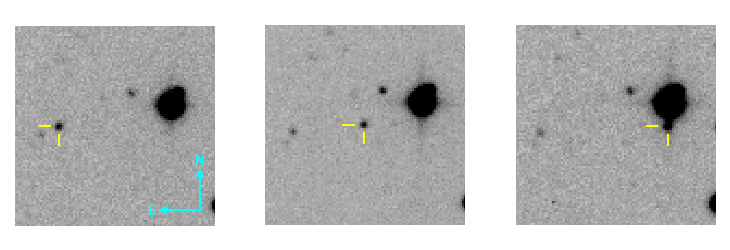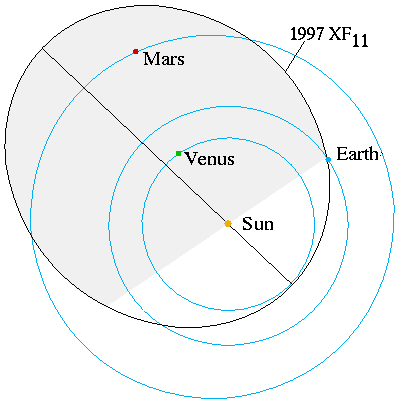The Spacewatch Project and 1997 XF11
On Kitt Peak near Tucson, AZ, two telescopes are dedicated to studying the population of asteroids and comets, providing information on objects that might present a hazard to the Earth, called Spacewatch (www.lpl.arizona.edu/spacewatch). They detect asteroids down to 10 meters in size, depending on distance and albedo (reflectance).

 In 1997, the NEA (near-earth asteroid), 1997XF11,
was discovered. Initial calculations
suggested a close approach of 30,000 miles in 2028.
(Earth-Moon distance is 260,000 miles). The size of 1997
XF11 is estimated to be about 1 km. Things were
getting scary (see 1998 CNN story here)
In 1997, the NEA (near-earth asteroid), 1997XF11,
was discovered. Initial calculations
suggested a close approach of 30,000 miles in 2028.
(Earth-Moon distance is 260,000 miles). The size of 1997
XF11 is estimated to be about 1 km. Things were
getting scary (see 1998 CNN story here)
Computations now constrain closest approach to 600,000 miles on Oct. 26, 2028. This is NOT the closest known PHA (potentially hazardous asteroid). Another 9 (as of 03/03) PHAs are known to be closer. Go Here for the list (1997 XF = 35396). Story about recent near encounter with asteroid 2004 FH, here
Other programs actively searching for NEAs: JPL and their Near Earth Object Program. Astronomers are also running two automated telescopes to search for these objects. To see orbits of some of the NEA, go Here, in particular, look at: 1997 FX = 35396. To see a movie of the objects in the Solar System, click here
Note: All searches are in the Northern Hemisphere! Concerned? Read more Here. Possible reward for finding near-earth asteroids! To read about efforts to save us from a collision, go here.